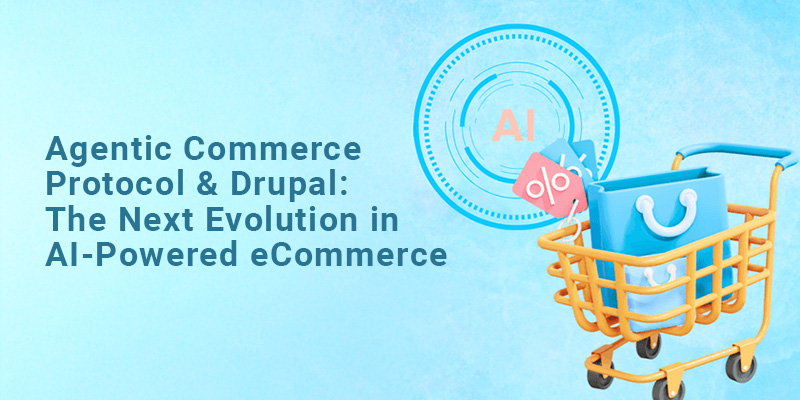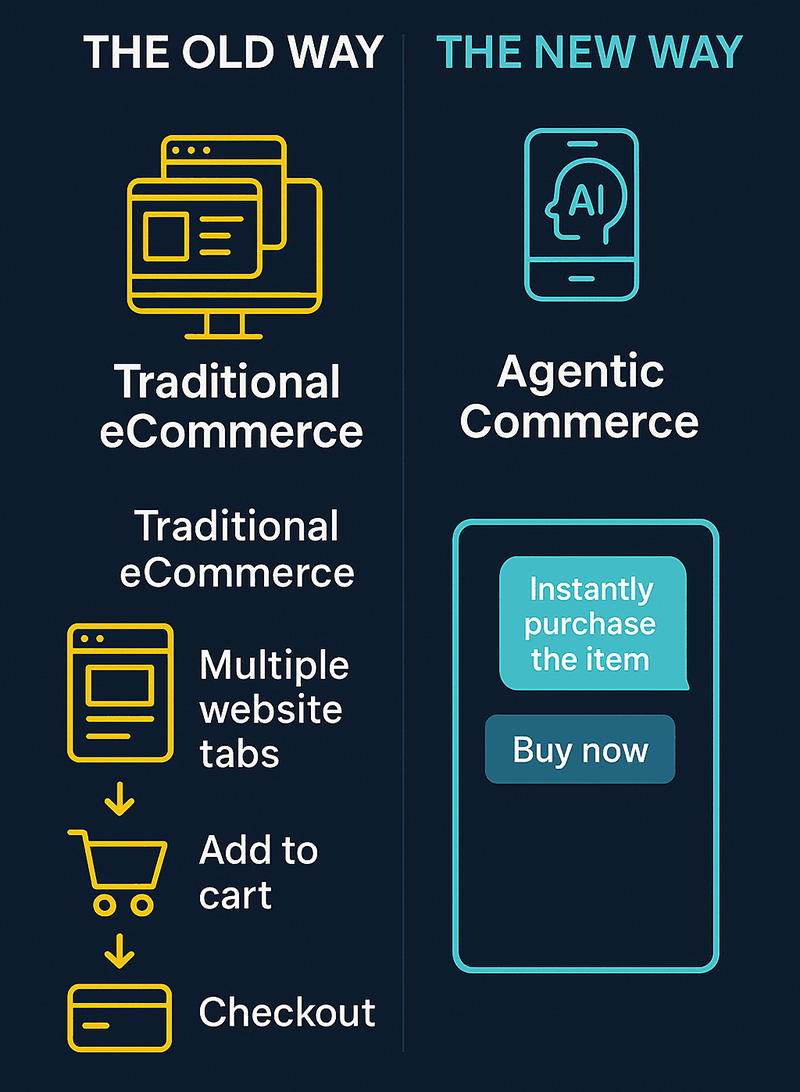Agentic Commerce Protocol & Drupal: The Next Evolution in AI-Powered eCommerce

Imagine a world where your online store doesn’t rely solely on clicks and menus, but anticipates, acts, and transacts entirely guided by AI. The notion of the buyer journey is evolving into something more proactive and autonomous. If your digital store isn’t built for this shift, you may be behind before you even notice.
Why Agentic Commerce Protocol(ACP) matters now

A beautiful website that lags won’t impress anyone. Google reports that 53% of visitors abandon a page that takes more than 3 seconds to load. Speed is not just a technical metric. It’s a business driver.
Here’s the reality: a new class of commerce is emerging. One where the transaction interface is an AI agent, not necessarily a website or app. The substance of the sale shifts from human-led browsing to agent-led procurement, encompassing discovery, evaluation, checkout, and fulfillment, all of which are handled in the background.
Research shows that agents could handle a large portion of routine commerce flows, reducing friction and enabling new efficiencies. According to research, the U.S. direct-to-consumer retail market alone could capture $900 billion to $1 trillion in revenue from agentic commerce flows by 2030.
This isn’t about minor UI polish anymore; it’s infrastructure, architecture, trust models, and experience redesign.
| Shift | Impact on Your Business |
|---|---|
| AI Drives Sales | Customers engage and purchase without browsing your site. |
| Instant Buying = More Conversions | No “add to cart” or redirects - faster, seamless transactions. |
| Smart Product Discovery | AI shows products when they match user intent, improving visibility. |
| Data Fuels Visibility | Detailed metadata boosts discoverability in AI conversations. |
| API-Ready Integration | Structured APIs enable faster, smoother integration into AI ecosystems. |
Why is Drupal in a strong position?
The open-source platform Drupal brings the flexibility, extensibility, and architectural openness that make it ideal for evolving commerce standards. Many commerce sites are being built for human-driven journeys today; Drupal allows you to reposition for agent-driven ones. With modules and custom development, you can create APIs, structured product feeds, dynamic checkout flows, and governance around delegated agent actions.
A developer community has already built experimental tools to help Drupal sites expose commerce endpoints suitable for agent-driven flows. That signals early readiness in this platform space.
Further, using Drupal means you retain complete control of your catalog, metadata, and experience layer, rather than being subject to closed-vendor black boxes. As commerce shifts toward agent-initiated flows, owning that stack becomes an advantage.
How Agentic Commerce & Drupal can work together

Here’s a practical breakdown of how the architecture might look:
1. Agent-Friendly Product Feed & Discovery
- Your product catalog must speak agent language: structured data, real-time inventory, semantic tags, and standardized endpoints.
- Drupal’s catalog backend (via Drupal Commerce or custom modules) can serve as the “source of truth” and expose APIs to agents.
2. Checkout & Fulfilment Integration
- The agent needs to build a cart, trigger payment and fulfilment, often without a traditional storefront interaction.
- With Drupal, you can integrate payment gateways, order management, and fulfilment workflows so that the invisible agent path works as well as the visible UX.
3. Data & Personalisation Loop
- Agents generate intent signals, purchase proxies, and new behaviour data. If your Drupal instance captures that data, you can optimise for future agent behaviour.
- Modules or custom logic can translate agent-initiated patterns into dynamic product suggestions, bundles, and promotions.
4. Governance, Trust & Agent Identity
- Autonomy means risk: which agent is acting on behalf of which customer? What spend limits apply? What identity checks?
- Drupal sites need to address those new identity/delegation workflows by building agent-identity modules or workflows around delegated permissions.
What this means for eCommerce teams
- Friction becomes a first-class enemy. With agents, every delay or missing endpoint is a performance leak. A site optimised for agents means fewer barriers, fewer redirects, fewer “must-clicks”.
- Touch-point ownership shifts. It’s no longer just about what the user sees; it’s about whether you can be discovered, engaged, and transacted with by an agent.
- Content and catalog strategy elevate. Poor metadata, inconsistent taxonomy and missing signals aren’t just user-UX issues; they’re discoverability failures in an agent-centric world.
- Open-source matters. Being “locked into” a rigid commerce stack becomes a weakness when agent-commerce protocols evolve. Drupal’s flexibility lets you adapt more rapidly.
- Your role as a CRO expert expands. Optimising for click-throughs and conversion funnels is only part of the story. You’ll also need to optimise for agent-flows: cart-build success, endpoint reliability, agent drop-offs, and agent-initiated conversions.
Real-world use cases to picture
- A shopper uses a voice assistant: “Find me a women’s leather jacket in size 38, under ₹12,000, available for shipping to Chennai by Friday.” The agent taps into your Drupal catalog, builds the cart, completes the payment, and selects shipping, eliminating the need for browsing.
- A B2B procurement bot acting on a departmental budget: “Reorder 50 units of Model X, same vendor, deliver to Bangalore site next week.” The agent uses your exposed endpoints to complete the transaction automatically.
- An influencer’s AI bot engaging bulk buyers: The bot triggers product drops, sets up limited-edition bundles, uses your catalogue’s metadata to inspire urgency, amplifying your Drupal-powered stack.
Key considerations and pitfalls
- Legacy architecture mismatch. Many Drupal sites today were built for human journeys; agent-ready endpoints may not exist, APIs may be missing, and product feeds may be incomplete.
- Catalog hygiene becomes critical. Missing metadata, inconsistent taxonomy, or inaccurate inventory will cause bots (and agents) to skip you.
- Trust, delegation, and fraud risk agents acting autonomously require a clear identity, defined boundaries, and established spending rules. Treat agents as first-class users.
- UX vs agent-UX dual-mode. You’ll still have human-facing shopping, but you’ll also need invisible agent paths. That means building “agent APIs” and human UX in parallel.
- Protocol maturity. The underlying agentic commerce standards are still in early adoption; being early is beneficial, but it also means that risk, tools, best practices, and the ecosystem are evolving.
- Content strategy shift. Agents rely less on human-facing search and more on structured metadata, intent signals, and contextual triggers. Your catalog needs to reflect that.
What this means for you as a CRO expert
Since you specialise in Conversion Rate Optimisation, here are the ways the dynamics change:
- Instead of only “make checkout simpler for humans,” you now optimise “make checkout discoverable, actionable, and successful for agents.”
- The conversion funnel expands: cart-build API success, agent query success rate, and agent-initiated drop-offs before human intervention.
- Your metrics shift: You’ll measure agent-initiated sessions, endpoint reliability, agent success rate, not just human click-throughs and abandonment.
By applying these to Drupal-powered stores, you’re ahead of the curve. Clients who adapt now will win the early mover advantage in agent-driven commerce.
Strategic roadmap for Drupal eCommerce leaders
1. Audit your catalog & feeds: Are all products richly described? Can agents query your data efficiently?
2. Upgrade your Drupal Commerce stack: Evaluate modules and custom development for APIs, headless commerce, and agent-friendly endpoints.
3. Build agent-native endpoints: Expose structured catalog, cart, checkout endpoints; create workflows that agents can call directly.
4. Test agent flows: Simulate “agent finds → builds cart → checkouts” and log any failures or drop-offs.
5. Monitor agent metrics: Add to your dashboard agent success rates, query failures, and conversions initiated by bots.
6. Define governance for agents: Set up identity, authorisation, spend limits, and monitoring on agent activity.
7. Lead content strategy toward agents: Shift from human-centric content to agent-centric metadata, dynamic bundling, and intelligent product descriptions.
Embracing the Agent-Ready Future
The convergence of agentic commerce flows and Drupal isn’t a minor UX trend; it’s a structural shift. For online stores built on Drupal, the opportunity is clear: start treating your commerce stack as agent-enabled rather than purely human-driven. Become discoverable to intelligent proxies, build checkout paths that require no human clicks, and take ownership of the new layer of commerce before others catch up.
Ready to act?
If you’re looking to audit your Drupal-based eCommerce site for agent-compatibility, optimise your product feed for AI-agent discovery, or build agent-first checkout flows, let’s connect. At Drupal Partners, we specialise in conversion-first strategies for this new era of commerce, so reach out to future-proof your digital store today.